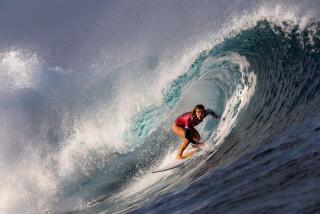‘SayWA’ Slogan Branded a Clever, or Clueless, Idea
- Share via
SEATTLE — Washington state’s new tourism brand campaign, “SayWA,” has its own website, which doesn’t extol the rain forests near the coast nor the wineries east of the Cascades. Instead, the website explains the brand itself.
“On the most basic level, WA=Washington,” the text reads. “So when you ‘SayWA,’ what you are saying, in effect, is ‘say Washington.’ This device functions to keep Washington top-of-mind, on the short list when considering travel destinations.”
All evidence of the problem, says Darrell E. Bryan: “It needs too much explanation.”
Bryan is general manager of Victoria Clipper, a ferry service that shuttles tourists throughout northern Puget Sound and lower British Columbia. He joins a crowd of befuddled Washingtonians whose response to the campaign is “Say what?”
“I lived in New York when they started the ‘I love New York’ campaign,” Bryan says. “That was a great phrase, right on message. Or take ‘Virginia is for lovers.’ No one has to explain that to make it work.”
SayWA represents a new direction for the state tourism office.
“It is a brand, not a slogan,” says Director Peter McMillin. “It is a catchy phrase, and it evolved from the research we did, the branding process.”
The initial magazine ads show different parts of the state, each with the SayWA phrase at the top and each with a different tagline.
The tagline with a picture of the Columbia Gorge reads: “This is the sound of jaws dropping.” A photo of a woman stomping grapes in eastern Washington is tagged with “This is the sound of taste buds dancing.”
The ads seek to evoke what campaign organizers call “a SayWA moment.”
“The primary purpose of any visual element is to portray an unforgettable experience, a story in the making,” the website states. “This story-like quality allows the reader (or viewer, or listener, as the case may be) to imagine themselves in the experience, in the SayWA moment, and thereby, in Washington.”
Developing the idea took 18 months and involved a 32-member brand development task force. The group included representatives from industry and chambers of commerce as well as tourism officials.
The campaign, with a $442,000 budget, began this month in magazines and on television. McMillin is quick to point out that the money, and the $150,000 spent on developing the brand, is part of the regular promotional budget of the state tourism office.
Those numbers point to another problem with the new brand. Washington’s tourism budget ranks No. 44 out of the 50 states for annual spending, according to the Travel Industry Assn. of America. The state’s $3.6-million budget is less than half of California’s, which is $8.1 million, and less than a third of the 50-state average, $12.8 million.
There are two ways to run a tourism campaign, says Daniel Fesenmaier, a professor at Temple University’s School of Tourism and Hospitality Management.
“You can have the instant recognition, the ones that make everyone say, ‘That’s brilliant,’ like Las Vegas and ‘What happens here stays here,’ or ‘I love New York’ -- phrases that have inherent meaning and are understood from the get-go,” Fesenmaier says.
“Or you can take a phrase that doesn’t intrinsically mean anything -- ‘Exxon,’ for instance, and ‘SayWA’ might be an example of this -- and with the right advertising, the right architecture, create the value. But that takes money.”
Fesenmaier says SayWA might evoke the intended response from residents of nearby states -- Oregonians or Californians. But that might not be the case for people who live farther away. Fesenmaier lives in Pennsylvania. His response to SayWA: “You might as well be speaking Chinese.”
Local news media have poked fun at the slogan.
The Spokesman Review in eastern Washington ran an editorial last week with the headline: “Actually I’d rather not SayWA, thanks.” A Seattle Times headline read: “SayWA, the sound of one hand clapping.” And the Olympian, the newspaper of the state’s capital, called the slogan ludicrous.
Tourism Director McMillan isn’t worried. He says he has heard from people who hate it and people who love it.
“SayWA was chosen to be different, to be catchy and to stand out,” he says. “We intended it to be noticed, and all of this buzz is a good thing.
“The point is to attract more visitors, to raise visitor spending. Branding is a process, and it is going to take a while to develop.”
More to Read
Sign up for The Wild
We’ll help you find the best places to hike, bike and run, as well as the perfect silent spots for meditation and yoga.
You may occasionally receive promotional content from the Los Angeles Times.






